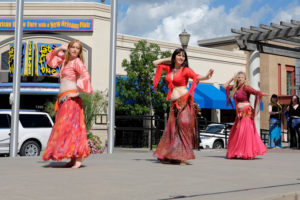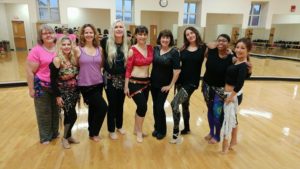In a single phrase, it takes passion, love for the music, a musical ear, commitment, an open mind, patience, supportive family and friends, and above all, thousands of hours of training and practice! Literarily! As one of my previous students simply put it “belly dancing is deceptively hard.” Like many other dance forms, it looks easy because we make it look easy. We were not born like this, or with any special talent. Any little movement that looks natural and intuitive, any hand position, any head turn comes from many hours of practice of that one single movement. And the learning never ends. There is always something that can be added to any move to take it to the next level, or to make it better. There is always a new move, a new combination to learn, or a new interpretation of the music, or a new style to explore. For who wants to learn.

From my experience, the most common progression of an aspiring dancer is to start in the beginner class to learn the foundation – body isolations and most common moves and traveling steps. On average, it takes two years for most people to get comfortable with these. I am talking coming to class consistently 1-2 times/week, plus additional practice at home. Then, in the intermediate level, they start to be in troupe numbers and learn group choreographies, for a number of years (about 3, give or take). Then, in the advancing level, they start to work on solos with guidance from teachers. It takes about 5 years for most people to start performing solo numbers. After about 7 years, they start making their own choreographies, and explore different styling. Eventually, experienced dancers (over 10 years) are able to do improvisational performances that are meaningful, beautiful, flowy and in tune with the music. Most of the professional dancers that I know and excel in their art have at least 10 years of consistent belly dance experience. At this time (in 2019), I have 14 uninterrupted years. 😊 So, it takes patience, and a lot of it! The good part is that everything can be achieved in belly dance if you give it time and practice.
As I said, the learning never stops, even after we started to teach our own classes. I’m still going to national or international belly dance workshops or festivals 3-4 times every year, take some specialty/advanced online classes, or receive occasional coaching from master instructors. Most of us do.
As far as my dance background and training, I’ve been active all my life. I started as a young girl in ballet and recreational gymnastics, then later in school and college I was involved in many sports at recreational level (fencing, basketball, swimming, skating, skiing, running, field tennis – for many years, table tennis, and probably others), then I did aerobics, yoga and other fitness activities for many years in my adult life (and still do). But the love for dance was always there. I tried ballroom dance and country dance for a while with my husband, which was fun, but I felt these were not satisfying enough, besides it was hard to coordinate our busy schedules to attend classes together.
My journey started in 2005 when I serendipitously discovered belly dance when I lived in Columbia, MO, fell in love with it from the first class, and the rest is history.
I took classes with Asha Diana for 2 years in CoMo, then moved to Lawrence, continued classes with Zada, and started to perform in her troupe for about 4-5 years. Then I moved to Kansas City and took classes with Zaina Ali and with Melody Gabrielle for a couple of years. Next, I decided to start a solo career, approx. 8 years after I first started belly dance, and started teaching my own classes in Jan 2015.
Meanwhile, along the years, I participated in numerous workshops and festivals with national and international class instructors in many belly dance styles, shows and competitions (won a few awards), and took online and private classes. Some of the most notable teachers I took from, more than one time in several cases, were (in no particular order):
Randa Kamel (several times)
Aziza of Cairo (several times, including master classes in baladi style)
Camelia of Cairo (several times, including master classes in Saidi style)
Luna of Cairo (several times)
Ibrahim Dimos (in Cairo)
Lubna of Cairo
Soraya Zaied of Cairo (several times)
Raqia Hassan (in Cairo and USA)
Dina (in Cairo)
Tommy King (in Spain)
Mohamed Shahin (several times)
Ossama Esam
Ozgen (Romani-Turkish style)
Nevena Tacheva (including online private classes)
Ahmed Hussien (including in person private classes)
Yousry Sharif
Oxana Bazaeva
Daria Mitskevich (in Spain)
Nathalie (of Los Angeles)
Simon Sako
Shahrzad (in Cairo)
Cassandra Shore
Dalia Carella
Sylvia Salamanca
Raksanna
Sahira
Andalee
Warda Shahrazd
Joe William (dance workshops on Delsarte three pillars of expression)
And the list is longer. I’m pretty sure I forgot to mention some. I feel very fortunate that I was able to attend these workshops and that I can continue to grow as a professional belly dancer, as I’m enjoying every minute of it! But attending (or teaching) classes is not enough. It’s the consistent practice that makes it better, and the willingness to receive feedback from those around me (other dancers, teachers, clients) and to improve. Add to that 3-4 hours of my own practice every week, sometimes more before shows.
So, if you ask me, that’s what it takes to become a dancer! 😊

